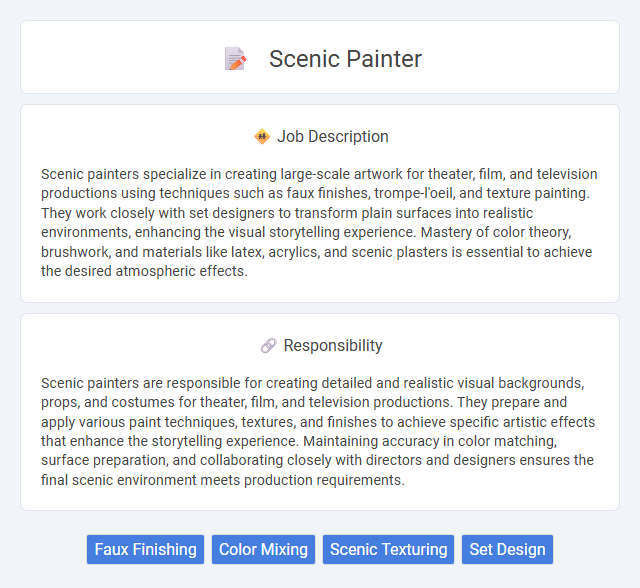
Scenic painters specialize in creating large-scale artwork for theater, film, and television productions using techniques such as faux finishes, trompe-l'oeil, and texture painting. They work closely with set designers to transform plain surfaces into realistic environments, enhancing the visual storytelling experience. Mastery of color theory, brushwork, and materials like latex, acrylics, and scenic plasters is essential to achieve the desired atmospheric effects.
People with strong attention to detail and creativity will likely be well-suited for a scenic painter job. Those who can work in physically demanding environments and have good spatial awareness probably find this role compatible with their skills. Individuals who prefer repetitive tasks or limited physical activity may not find this job a good match.
Qualification
Scenic painters must possess a strong foundation in fine arts, with expertise in color theory, brush techniques, and surface preparation to create realistic and imaginative backdrops for film, theater, and television productions. Proficiency in working with various painting mediums such as acrylics, oils, and watercolors is essential, along with experience in interpreting design sketches and blueprints accurately. Candidates often require formal training from art schools or specialized scenic painting programs, combined with hands-on experience in a collaborative set environment to meet production deadlines and artistic standards.
Responsibility
Scenic painters are responsible for creating detailed and realistic visual backgrounds, props, and costumes for theater, film, and television productions. They prepare and apply various paint techniques, textures, and finishes to achieve specific artistic effects that enhance the storytelling experience. Maintaining accuracy in color matching, surface preparation, and collaborating closely with directors and designers ensures the final scenic environment meets production requirements.
Benefit
Scenic painters likely experience significant benefits including creative expression and skill development in various painting techniques. Opportunities for collaboration in theater or film production may enhance professional networks and job satisfaction. Financial stability could improve through steady work on diverse projects within the entertainment industry.
Challenge
Scenic painters likely face the challenge of accurately transforming conceptual artwork into large-scale, detailed backdrops while working under tight deadlines. The probability of encountering complex textures and color matching issues is high, demanding both technical skill and creative problem-solving. Balancing artistic vision with practical constraints frequently tests their adaptability and precision.
Career Advancement
Scenic painters enhance theatrical productions by creating detailed backdrops and set elements that bring stage designs to life. Mastery of various painting techniques and materials opens opportunities for advancement to lead scenic artist or art director positions. Gaining experience with digital design tools and collaborating closely with production teams further accelerates career growth within the entertainment industry.
Key Terms
Faux Finishing
Scenic painters specializing in faux finishing expertly replicate textures such as marble, wood grain, and aged plaster to create immersive stage environments. Their skills in layering paints, glazes, and specialty coatings enhance theatrical productions by adding depth and realism to set designs. Mastery of color theory and surface treatments ensures visually striking backdrops that support narrative storytelling.
Color Mixing
Scenic painters specializing in color mixing use advanced knowledge of pigments, hues, and lighting effects to create realistic and vibrant set designs. They expertly blend paints to achieve precise tones that enhance the atmosphere and mood of theatrical productions, film sets, and commercials. Mastery of color theory and materials ensures seamless integration of painted scenery with lighting and surrounding elements.
Scenic Texturing
Scenic painters specializing in scenic texturing create realistic surface finishes that enhance theatrical and film set designs by mimicking materials such as wood, stone, and fabric through detailed brushwork and layering techniques. Their expertise in texture application contributes to immersive environments, supporting the visual storytelling by providing depth and authenticity to the scenery. Proficiency in various painting mediums, surface preparation, and knowledge of color theory are crucial for achieving believable textural effects that hold up under stage lighting and camera scrutiny.
Set Design
Scenic painters transform set designs into immersive visual environments by applying paint, textures, and finishes to various surfaces on stage. Their expertise in color theory, materials, and brush techniques enhances the mood and authenticity of theatrical productions, closely collaborating with set designers to realize artistic visions. Mastery of perspective and detailing ensures scenes come alive, supporting storytelling through vivid and believable backdrops.
 kuljobs.com
kuljobs.com